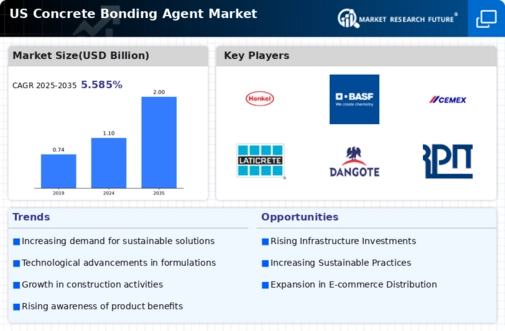The US Concrete Bonding Agent Market exhibits a competitive landscape characterized by diverse players who offer a variety of products catering to the construction and repair sectors. This market is driven by the increasing demand for durable and effective bonding solutions used in residential, commercial, and industrial applications. As infrastructure development gains momentum, the need for high-performance bonding agents becomes integral, leading to innovation and strategic collaboration among market participants. Companies within this space are engaging in research and development to enhance product efficiency, sustainability, and application ease, positioning themselves to meet evolving customer preferences and regulatory standards.
Competitive dynamics are defined not only by product offerings but also by customer service, distribution channels, and marketing strategies that yield strong brand loyalty and market penetration.Henkel has established a significant foothold within the US Concrete Bonding Agent Market, leveraging its extensive portfolio to cater to a variety of customer needs. Its focus on high-quality formulations and performance-driven products has strengthened its market presence, enabling the company to maintain a competitive edge. Henkel’s emphasis on research and innovation allows it to deliver advanced bonding solutions that meet the diverse requirements of the construction industry.
In addition to product performance, the company is recognized for its commitment to sustainability, which resonates with environmentally conscious consumers. The robust distribution and sales networks further enhance Henkel's ability to effectively reach a broad customer base, solidifying its status as a key player in the US market.BASF also maintains a strong presence in the US Concrete Bonding Agent Market, known for providing a wide range of innovative products that cater to various applications in construction. The company specializes in producing high-performance bonding agents that enhance the durability and adhesion of concrete materials.
BASF’s portfolio includes key products designed to improve the efficiency of construction processes, reflecting its commitment to quality and innovation. The company actively engages in mergers and acquisitions, allowing it to expand its product offerings and market reach within the United States. Furthermore, with a strong emphasis on sustainable practices and environmental responsibility, BASF is well-positioned to meet the growing demand for eco-friendly construction materials. Their strategic initiatives and product advancements contribute significantly to their competitive strength in the US Concrete Bonding Agent Market, enabling the company to effectively fulfill customer needs while addressing industry trends.























Leave a Comment